0234ss10
0234ss10.doc
Performance Evaluation Studies on Wastewater Laboratories (Renewal)
OMB: 2080-0021
Information Collection Request for
Performance Evaluation Studies of Wastewater Laboratories
June 2010
Prepared by:
U. S. Environmental Protection Agency
Office of Enforcement and Compliance Assurance
Office of Compliance
Agriculture Division
Agriculture Branch
1200 Pennsylvania Ave., NW
Washington, D.C. 20460
TABLE OF CONTENTS
1 IDENTIFICATION OF THE INFORMATION COLLECTION 1
1(a) Title and Number of the Information Collection 1
2 NEED FOR AND USE OF THE COLLECTION 2
2(a) Need/Authority for the Collection 2
2(b) Practical Utility/Users of the Data 2
3 NONDUPLICATION, CONSULTATIONS, AND OTHER COLLECTION CRITERIA 3
3(b) Public Notice Required Prior to ICR Submission to OMB 3
3(d) Effects of Less Frequent Collection 3
4 THE RESPONDENTS AND THE INFORMATION REQUESTED 5
4(a) Respondents and NAICS/SIC Codes 5
5 THE INFORMATION COLLECTED – AGENCY ACTIVITIES, COLLECTION METHODOLOGY AND INFORMATION MANAGEMENT 7
5(b) Collection Methodology and Management 7
5(c) Small Entity Flexibility 7
6 ESTIMATING THE BURDEN AND COST OF THE COLLECTION 8
6(a) Estimating Respondent Burden 8
6(b) Estimating Respondent Costs 9
6(c) Estimating Agency Burden and Costs 11
6(d) Estimating the Respondent Universe and Total Burden and Costs 11
6(e) Bottom Line Burden Hours and Cost Tables 12
6(f) Reasons for Change in Burden 12
APPENDIX A: LIST OF CHEMISTRY & MICROBIOLOGY ANALYTES AND WET TEST METHODS 14
1 IDENTIFICATION OF THE INFORMATION COLLECTION
1(a) Title and Number of the Information Collection
Performance Evaluation Studies of Wastewater Laboratories. OMB Control No. 2080-0021, ICR No. 0234.10.
This is a request for a new Information Collection Request (ICR) to support the collection of Proficiency Testing (PT) data to test the performance of laboratories that conduct discharge analyses for the Discharge Monitoring Report – Quality Assurance study program (DMR-QA). This request will replace the expiring ICR (Performance Evaluation Studies of Water and Wastewater Laboratories (OMB Control No. 2080-0021, EPA ICR No. 0234.09)). This ICR refers only to DMR-QA. Therefore, the figures for burdens only support DMR-QA. EPA is requesting a standard three-year clearance for this ICR.
Chemical monitoring data for drinking water and wastewater are submitted from a variety of laboratories to the United States Environmental Protection Agency (EPA) every year. These results must be relied on by EPA, as they form the primary basis for its regulatory decisions. In order to provide an objective demonstration that these laboratories are submitting reliable information, the subject Performance Evaluation (PE) studies were developed. Participation in the Discharge Monitoring Report - Quality Assurance (DMR-QA) studies is mandatory for major wastewater dischargers and selected minor dischargers under the National Pollutant Discharge Elimination System (NPDES) permit. Major dischargers are defined as facilities that discharge at least 1 million gallons of waste water per day and also those facility(s) servicing at least 10,000 homes. Minor dischargers are selected to monitor the analytes/toxics discharged by the facility.
EPA originally administered the preparation of test standards for the program as part of the Agency’s mandate to assure the quality of environmental monitoring data submitted by NPDES permit holders (permittees). Currently, preparation, distribution and grading of the test standards for have been privatized to lessen EPA’s burden in carrying out this mandate. Private sector companies, known as Proficiency Testing (PT) providers, manufacture and distribute test samples to the contract and in-house laboratories. The laboratories submit their analytical results to the PT providers for evaluation. The PT providers evaluate the submitted data and send the graded results back to the laboratories. These laboratories then forward copies of their graded data to their permittee clients, who will review the results and forward the data to their designated certifying/enforcement authorities. Providers also send electronic copies of the graded results to the designated certifying/enforcement authorities and to EPA. These graded results include the names and addresses of the laboratories, the analytes that were tested, the concentration of the analyte, and the acceptance criteria and evaluations.
EPA is required to conduct this ICR analysis because more than nine non-Federal entities will be asked to respond to these data requests. Because state agencies use the resulting data for their own laboratory certification/enforcement programs, and are not reporting any information from the PT studies to EPA, they do not incur any burden under this ICR. In addition, cost and burden to PT Providers are not considered in this ICR because the vendor costs associated with this program are accounted for in the pricing of their standards (i.e., the costs incurred by the Providers is factored into the cost of the PT standards).
The total annual burden and labor costs incurred by the 6,589 permittees associated with this ICR are estimated to be 41,511 hours and $2,461,426 per year over the 3-year ICR period (2011-13). EPA estimates that it takes 6.3 hours and costs $373.57 per year per respondent to comply with this requirement. Respondent labor costs are linked with the time it takes to read and understand the annual DMR-QA announcement sent by EPA, plan activities, analyze PT standards, report information to the PT providers, and maintain records. Respondent operation and maintenance (O&M) costs are associated with purchasing the PT standards. No costs or burdens to PT Providers or state regulatory agencies are associated with this ICR.
2 NEED FOR AND USE OF THE COLLECTION
2(a) Need/Authority for the Collection
Laboratory Performance Evaluation (PE) studies are designed to fulfill the need to monitor the quality of analytical data for select critical analytes within major point-source discharge samples. Results from the PE studies over time have generally shown a slow but regular improvement in average performance by the laboratories producing the monitored data. By helping laboratories identify and correct analytical problems, the PE studies are also responsible for documented improvement in this data.
Public Law 92-500, the Federal Water Pollution Control Act Amendments of 1972, and the related regulations in 40 CFR part 136, required extensive analysis of water and wastewater samples by EPA, state, local government and private laboratories, to maintain ambient water quality and control point-source discharges. These monitoring requirements were continued in the Clean Water Act of 1987 § 308(a) (Federal Water Pollution Control Act, Public Law 100-4, 33 U.S.C. § 1318). EPA bases many important decisions upon this data. The data quality depends heavily upon the availability of capable laboratory analysis at all levels and reliability must be ensured.
2(b) Practical Utility/Users of the Data
States and laboratory personnel will use the results of these studies to identify problems associated with laboratory analysis and substandard facility discharges. This will improve the quality of water data in critical monitoring areas and the quality of facility discharge returned to the environment. These studies have demonstrated that problems exist and arise periodically with all dischargers and water testing laboratories; without future studies, many such problems will go unrecognized and unresolved. Results from the DMR-QA studies are used to highlight NPDES facilities and laboratories with apparent analytical problems that should be inspected on-site by state regulatory personnel. Results from the PT studies are used by State personnel as a major part of the basis for certifying laboratories to produce required regulatory data and as a base for potential regulatory enforcement.
3 NONDUPLICATION, CONSULTATIONS, AND OTHER COLLECTION CRITERIA
The DMR-QA accepts data and results from any of the other federally sponsored water quality programs, such as the Water Pollution (WP) program, as long as the laboratories meet the condition that they perform the PE sample analyses between January 1st and the last day of the DMR-QA study. The DMR-QA study commences on or around March 15th, and concludes on or around June 30th of each year. EPA has granted waivers to 5 states to use their state laboratory certification program in lieu of their permittees participating in DMR-QA. Four of these waivers have been granted since the last ICR was renewed in December 2007.
3(b) Public Notice Required Prior to ICR Submission to OMB
In compliance with the Paperwork Reduction Act, a notice of this Information Collection Request ICR was published in the Federal Register on June 16, 2010 (75 FR 34110),
The DMR-QA has been administered by the EPA for over 30 years. The Office of Research and Development initiated and administered the program until the responsibility was assigned to Office of Enforcement and Compliance Assurance (OECA). OECA will consider any comments received and make appropriate adjustments to the program. The seven PT providers are accredited by the American Association for Laboratory Accreditation (A2LA).
A2LA is a nonprofit, non-governmental, public service, membership society. The mission of A2LA is to provide comprehensive services in laboratory accreditation and laboratory-related training.
The list of PT providers is available at http://a2la.org/dirsearchnew/nelacptproviders.cfm.
EPA also contacted the PT Providers; three responded, all wish to remain anonymous. The PT Providers were asked to give their input on the estimate for time burdens as well as the fees which labs need to pay for samples provided by the PT Providers. The three PT Providers that responded indicated that it cost on average $280 to $320 per laboratory for samples. An average was obtained of $300 per laboratory. It must be kept in mind that this is the cost that in-house and contract laboratories pay, and this is passed onto the permittee. Therefore, if a lab is contracted by several permittees, then EPA considers that the $300 will be distributed evenly among the permittees. However, if a permittee employs an in-house laboratory, the permittee is burdened with the entire cost of obtaining samples ($300) as well as the labor costs of the laboratory. Since the ratio of in-house and contract laboratories is unknown, an average was obtained for all laboratories and a ratio of 0.633 permittee per laboratory was used. This ratio is the same as used in the 2007 ICR. Therefore, the cost of obtaining samples is estimated to be $190 per permittee, using the ratio of 0.633 laboratory per permittee.
3(d) Effects of Less Frequent Collection
The current frequency for the DMR-QA is judged to be the minimum needed to assess the accuracy of data production required by discharge permits. Under DMR-QA, laboratories producing data are expected to demonstrate adequate analytical proficiency once each year for each analyte they test routinely for their NPDES permittee clients. Collecting water quality data less than once per year to measure the accuracy of laboratory work would potentially delay corrective actions required by the permittee and therefore compromise discharge water quality.
This ICR was prepared in accordance with the October 2009 version of the ICR Handbook developed by EPA's Office of Environmental Information, Office of Information Collection, Collection Strategies Division. The ICR Handbook provides the most current instructions for ICR preparation to ensure compliance with the 1995 Paperwork Reduction Act (PRA) Amendments and OMB's implementing guidelines.
EPA believes participation in these studies is a reasonable requirement for all laboratories routinely producing data for environmental water regulation. Any public health data on drinking waters, ambient waters or effluents under regulation deserve the minimal quality assurance check that these studies represent.
This information collection does not require respondents to disclose confidential information.
No questions of a sensitive nature are included in any of the information collection requirements outlined in this ICR.
4 THE RESPONDENTS AND THE INFORMATION REQUESTED
4(a) Respondents and NAICS/SIC Codes
Respondents in DMR-QA studies are NPDES permittees designated by the EPA region or state with permitting responsibility and the laboratories doing chemical/microbiological analysis and whole-effluent toxicity testing for these major dischargers. These respondents are most likely from the following SIC Codes:
2011 - through 3999 - Manufacturers
4941 - Water supply systems
4952 - Sewerage systems
8734 - Water testing laboratories
4(b)(i) Data Items
In all laboratory PE studies, the data result from analyses of synthetic samples that contain known amounts of specific compounds, usually dissolved in reagent water. In DMR-QA studies, the compounds are those of primary interest with regard to the monitoring requirements in the NPDES permits. All studies also collect sufficient data to properly identify and characterize the respondents. Each respondent reports only data for that portion of the study analytes for which they wish to be certified or as directed by the responsible regulatory official.
4(b)(ii) Respondent Activities
The primary burden involves analyzing and reporting results for relevant study samples according to instructions. Based on the current DMR-QA study, 6,589 respondents participate in certification studies.
The DMR-QA program requires 6,589 permittees to submit results annually. A percentage of these permittees do all the work onsite themselves, using in-house laboratories. The remaining permittees contract at least some of the analysis to a commercial laboratory(s). The commercial laboratory may do work for many permittees; the DMR-QA results would then be sent to these permittees. Therefore, there are fewer labs than permittees. However, EPA does not have data on how many in-house laboratories and contract laboratories are used. Furthermore, EPA does not track how many laboratories participated in one or more studies or how many permittees participated in only chemistry and microbiology and those that also participated in WET testing. EPA is estimating the “maximum” impact of the DMR-QA program on the regulated community. EPA will assume that all 6,589 permittees will fulfill requirements for the top 10 chemistry & microbiology analytes and the top 10 WET test methods. EPA believes this ICR may overestimate the burden because not all permittees do WET testing. (See Appendix B for a list of the top 10 chemistry & microbiology analytes and the top 10 WET test methods).
To calculate the burden incurred on laboratories performing PE samples, EPA used a ratio of 0.633 laboratories per NPDES permittee. This ratio was calculated based on data procured by 4 PT Providers in 2006. EPA assumes that the ratio of laboratories per permittee has not changed significantly since the last ICR was approved. Based on this ratio (0.633 laboratories per NPDES permittee) and that there are 6,589 permittees participating in the DMR-QA, EPA estimates there are a total of 4,171 laboratories performing PE studies under DMR-QA. To provide an estimate of respondent burden for the WET testing portion of DMR-QA, EPA determined that an average of 4.77% of all laboratories participating in DMR-QA perform WET PE tests, or 227 laboratories. This percentage is also based on the information from the 4 providers received in 2006.
EPA is not estimating the burden for the PT Providers, because this burden is internalized in the cost of obtaining PE samples from the PT Providers.
Respondents (permittees) will participate in the following activities:
Read Instructions: Each of the 6,589 respondents will read the instructions provided by EPA.
Plan Activities: Each of the 6,589 respondents will incur burden to plan activities associated with the PT studies.
Analyze Chemistry and Microbiology Analytes: EPA assumes that all 6,589 respondents will participate in the PT studies for microbiology, trace metals, demands, minerals, nutrients, and miscellaneous analytes as required by respondents’ permits. EPA assumes that 4,171 in-house and contract laboratories will do the work for the 6,589 permittees.
Analyze WET: EPA assumes that all 6,589 permittees will participate in the PT studies for WET. It is assumed that 227 in-house and contract laboratories will do the work for the 6,589 permittees.
Report Results: Each of the 6,589 respondents will incur burden to report its study results to the PT provider.
Maintain Records: Each of the 6,589 respondents will incur burden to maintain records associated with the PT study.
5 THE INFORMATION COLLECTED – AGENCY ACTIVITIES, COLLECTION METHODOLOGY AND INFORMATION MANAGEMENT
EPA has reduced its activity related to this information collection to that of providing general guidance and oversight for the PT Providers and the participating laboratories on an as needed basis.
5(b) Collection Methodology and Management
EPA will notify the permittee of their requirement to participate in the relevant PE program annually. The permittee’s in-house or contract laboratory will then select an accredited private PT Provider to provide them with the appropriate samples. The testing facility will then send the analysis data of these samples to the PT Provider. The permittee will use the form approved by OMB to report DMR-QA results. This form will be available in two formats: a hard copy that will be part of the announcement which is mailed annually and an online PDF form, available on the EPA website. This PDF form can be filled out and then printed for submission. The PT Provider will send evaluations of the submitted data back to the permittee and the designated certifying/enforcement authority. PT Providers will also send summary data in electronic form to EPA for archiving.
The major requirement under Small Business Regulatory Enforcement Fairness Act (SBREFA) is a regulatory flexibility analysis of all rules that have a "significant economic impact on a substantial number of small entities." Since this data request is not part of a rule, this ICR is not subject to SBREFA.
EPA determines the requirements for the frequency that a permittee must demonstrate proficiency by passing a PE study. The study typically starts on or around March 15th and ends on or around June 30th. The participating permittees’ in-house/contract laboratories demonstrate their proficiency by passing a PE study conducted by an accredited PT Provider for a fee. The PT Provider must submit the results of each study to the state and EPA regional coordinator, as well as the EPA National Coordinator.
In summary: each participating in-house or contract laboratory must report test results to the PT Provider once a year. The PT Provider must electronically submit the results of all studies they conduct to participating permittees and state and EPA regional coordinators. Participating permittees must re-qualify for each analyte it reports one year from the last certification that it received.
6 ESTIMATING THE BURDEN AND COST OF THE COLLECTION
This section describes the estimated average annual burden and costs for the information collection activities for PT studies that will be conducted by laboratories. For this data submission, PT providers and state agencies and EPA have no burden and costs; this is discussed further in Section 6(a). The Agency's burden and cost estimates are outlined in Section 6(c).
To estimate the costs, EPA made assumptions about the burden associated with activities that would likely be needed to fulfill the request. EPA emphasizes that the per-respondent estimates represent the average burden and cost over the 3-year period covered by this ICR (2011-2013). Some respondents may incur higher costs and some will fall below the average. EPA made the assumption that all respondents perform all the tests included in this analysis. As a result, the time burden may be a bit on the higher end.
Burden and costs are not distinguished by categorized entities, public (federal, state and local government dischargers) and private (commercial, industrial and others) sectors, because EPA currently does not track this information. EPA’s best estimate is that from the total of 6,589 permittees, there are 3,148 state and local government facilities and 3,441 commercial facilities
6(a) Estimating Respondent Burden
The average annual respondent burden (in labor hours) for permittees is shown in Table 6.1. PT Providers conduct the studies, removing this burden from EPA. Participating laboratories receive samples from the PT Provider, return test results to the PT Providers and the PT Providers evaluate the data and send reports to the laboratories, the state accrediting authorities and EPA. The total burden on the laboratories is 41,511 hours, with an average of 6.3 hours per respondent (41,511 total hours divided by 6,589 permittees). This estimate includes burden for participating laboratories to read instructions, plan activities, analyze samples, submit data to the PT vendors, and maintain records.
EPA assumes that the respondent burden will be divided among three labor categories: manager, chemist, and records clerk. The labor associated with each of the ICR activities are discussed in more detail below.
Read Instructions: EPA assumes that each of the 6,589 respondents will require 0.5 hour to read the instructions provided by EPA. The burden will be evenly divided between a manager and chemist.
Plan Activities: EPA assumes that the manager of each laboratory will require 0.5 hours to plan activities associated with the PT studies. The burden will be divided between a manager and chemist.
Analyze Chemistry and Microbiology Analytes: A total of 6,589 permittees are expected to use a total of 4,171 laboratories (a ratio of 0.633 laboratories for every permittee). Analysis is assumed to require approximately 1.8 hours to analyze PT standards for the top 10 analytes. All hours will be incurred by a chemist. See Appendix B for these tests and the estimated time for an analysis. These estimates assume that the laboratory is adding a DMR-QA sample to the normal processing that occurs in the laboratory using an already calibrated instrument/process.
Analyze WET: A biologist or project manager constructs the test chambers and records organism mortality (morbidity) of test organisms while a chemist analyzes the water chemistry. Biologists and chemists are assumed to require 2.4 hours to analyze PT standards for WET. It is assumed that 227 laboratories do this work for all 6,589 permittees. These estimates assume that the laboratory is adding a DMR-QA sample to the normal processing that occurs in the laboratory using an already calibrated instrument/process.
Report Results: EPA assumes that each of the 6,589 respondents will require 1.0 hours to report the results of the study to the PT Provider. The burden will be divided between a manager and records clerk.
Maintain Records: EPA assumes that a records clerk in each of the 6,589 laboratories will require 0.1 hours to maintain the files from the PT study.
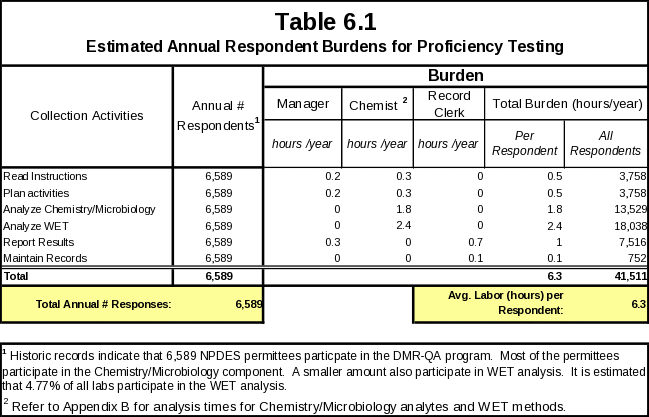
6(b) Estimating Respondent Costs
Table 6.2 shows the annual average costs for laboratories over the 3-year ICR period. Average annual labor costs for all 6,589 permittees are estimated to be $1,209,516. Average annual O&M costs are estimated to be $1,251,910. EPA estimates each laboratory will incur an annual average labor plus non-labor cost of $373.57 for this data collection effort. (see Table 6.2).
6(b)(i) Respondent Labor
The labor cost was arrived at by estimating the amount of labor required to participate on an annual basis in the DMR-QA study. Labor costs are based on information provided by the U.S. Department of Labor Statistics, May 2008, National Industry Specific Occupational Employment and Wage Estimate. The labor categories include a manager at an hourly rate of $51.23, a data entry clerical person at an hourly rate of $13.25, and a skilled technician or chemist to conduct the measurements at an hourly rate of $28.16. These values were adjusted for inflation using the U.S. Department of Labor Bureau of Labor Statistics’s CPI calculator (http://data.bls.gov/cgi-bin/cpicalc.pl). Table 6.2 lists the estimated burden and costs for labor related to each activity. The annual respondent labor cost, for all 6,589 respondents is estimated to be $1,196,910 for 41,511 hours.
6(b)(ii) Respondent Operation and Maintenance Costs
Operation and Maintenance (O&M) costs for laboratories include all costs related to providing personnel with the space, equipment and materials necessary to perform the tasks required by this ICR. Since laboratories are driven by their compliance monitoring requirements to purchase the analytical instrumentation and computers and not by this ICR, no capital costs are be considered associated with this ICR. Only the costs associated with purchasing the PT standards is appropriate for consideration in this category.
Permittees may participate in the PT studies for some or all of the chemistry, microbiology analytes and WET test methods (refer to Appendix A for a list of chemistry and microbiology analytes and WET test methods). The cost of the PE samples varies with the costs for the analytes, microbiological and WET testing required for each calendar year. This is complicated by the fact that the participants in any given study need not analyze all of the samples available for that study, only the ones that are required by their permits. EPA estimated a cost of $300 per laboratory based on feedback from PT Providers who did an analysis of the average cost of buying PE samples.
Because EPA does not have sufficient information to estimate how many analytes are contained in the PT samples sent to each laboratory, EPA assumes that a single PT sample contains standards for the top ten analytes for chemistry and microbiology and the top 10 WET test methods, based on information from the PT Providers. Therefore, laboratories participating in the chemistry and microbiology PT study are assumed to receive and run analyses for 10 analytes. Similarly, those participating in the PT study for WET would receive samples for each of 10 WET test methods. EPA estimates the costs of obtaining PT samples to be $300 per laboratory and $190 per permittee (respondent). Average annual O&M costs (fees for PE samples) for the respondents is estimated to be $1,251,910.
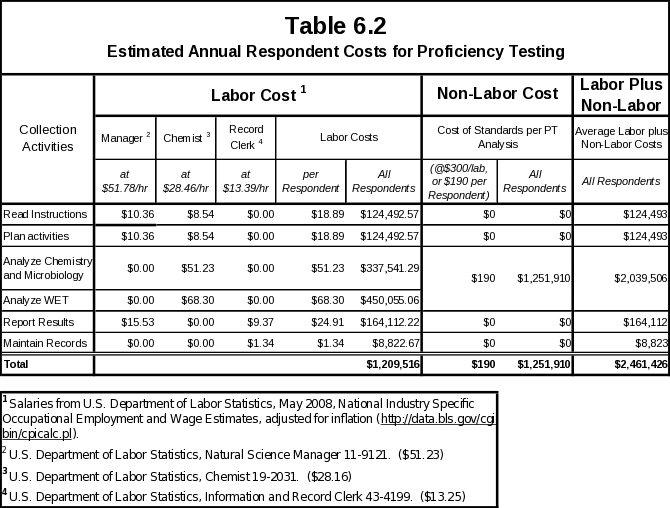
6(b)(iii) Capital/Startup Operating and Maintenance (O&M) Costs
There are no Capital/Startup costs associated with this information collection. The annual Operating and Maintenance costs associated with this ICR are estimated to be $190 per respondent.
6(c) Estimating Agency Burden and Costs
Since EPA’s role has been reduced to an advisory level only, there is no longer any burden to the Agency, other than the time required to put together the annual announcement and printing and mailing costs of the annual announcement. On average, 6,750 announcements are printed annually, to send out to permittees, PT Providers, state and regional coordinators as well as spare copies. The annual burden is estimated below:
Maintaining records of active participants in the program: 80 hours
Putting together the annual announcement and answering questions: 480 hours (40 hours/month)
Cost of printing 6,750announcements: $5,000
Cost of mailing announcements: $6,000
Total annual burden and cost to EPA: 560 hours and $11,000
6(d) Estimating the Respondent Universe and Total Burden and Costs
The only respondents for this ICR are NPDES permittees. They may use contract laboratories to perform the work, but the burden is considered to be upon the permittees, since they bear the costs of labor and operations & maintenance. As itemized in section 6(b), the annual respondent burden is 6.3 hours and $373.57 per participant. The total annual respondent burden is 41,511 hours and $2,461,426 for 6,589 participants. Currently, there are 7 PT Providers. PT Providers’ burdens are not assessed in this ICR because their cost burden for this ICR is part of the estimated PE sample cost burden for the laboratories. Burden and costs to EPA is minimal, being limited to the drafting of the annual announcement and printing/mailing costs, which come to a total of 560 hours and $10,962.21 on an annual basis.
6(e) Bottom Line Burden Hours and Cost Tables
The bottom line burden hours and costs for this ICR are shown in Table 6.3. This includes the burden and costs to the 6,589 laboratories that are affected by this ICR.
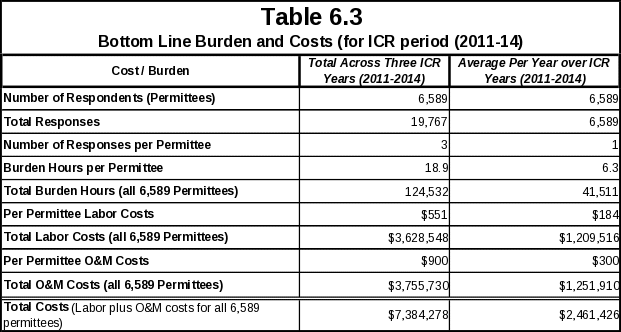
6(f) Reasons for Change in Burden
Participation in the DMR-QA PE study has decreased from an estimated average of 7,516 to 6,589 since the last renewal of this ICR. This is due to EPA granting a waiver to four additional states, allowing them to employ their state laboratory certification program as an adequate substitute for the federal DMR-QA program.
Labor and Operation & Maintenance costs were updated since the previous renewal of this ICR. Operation & Maintenance costs reflect the costs of obtaining PE samples from the PT Providers. The estimated average cost of obtaining PE samples increased from $165 per respondent (permittee) to $190 per respondent.
The average annual respondent burden for each permittee is estimated to be 6.3 hours per response. Burden means the total time, effort, or financial resources expended by persons to generate, maintain, retain, or disclose or provide information to or for a Federal agency. This includes the time needed to review instructions; develop, acquire, install, and utilize technology and systems for the purposes of collecting, validating, and verifying information, processing and maintaining information, and disclosing and providing information; adjust the existing ways to comply with any previously applicable instructions and requirements; train personnel to be able to respond to a collection of information; search data sources; complete and review the collection of information; and transmit or otherwise disclose the information. An agency may not conduct or sponsor, and a person is not required to respond to, a collection of information unless it displays a currently valid OMB control number. The OMB control numbers for EPA's regulations are listed in 40 CFR part 9 and 48 CFR Chapter 15.
To comment on the Agency's need for this information, the accuracy of the provided burden estimates, and any suggested methods for minimizing respondent burden, including the use of automated collection techniques, EPA has established a public docket for this ICR under Docket ID No. EPA-HQ-OECA-2010-0413, which is available for online viewing at www.regulations.gov, or in person viewing at the Enforcement and Compliance Docket in the EPA Docket Center (EPA/DC), EPA West, Room 3334, 1301 Constitution Ave., NW, Washington, DC. The EPA/DC Public Reading Room is open from 8:30 a.m. to 4:30 p.m., Monday through Friday, excluding legal holidays. The telephone number for the Reading Room is 202-566-1744, and the telephone number for the Enforcement and Compliance Docket is 202-566-1752. An electronic version of the public docket is available at www.regulations.gov. This site can be used to submit or view public comments, access the index listing of the contents of the public docket, and to access those documents in the public docket that are available electronically. When in the system, select “search,” then key in the Docket ID Number identified above. Also, you can send comments by mail to the Office of Information and Regulatory Affairs, Office of Management and Budget, 725 17th Street, NW, Washington, DC 20503, Attention: Desk Office for EPA. Please include the EPA Docket ID No. EPA-HQ-OECA-2010-0413 and OMB control number 2080-0021 in any correspondence.
APPENDIX A: LIST OF CHEMISTRY & MICROBIOLOGY ANALYTES AND WET TEST METHODS
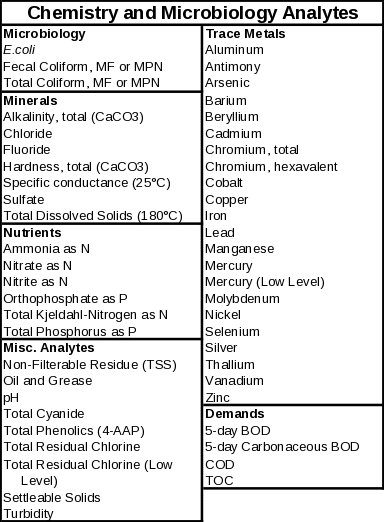
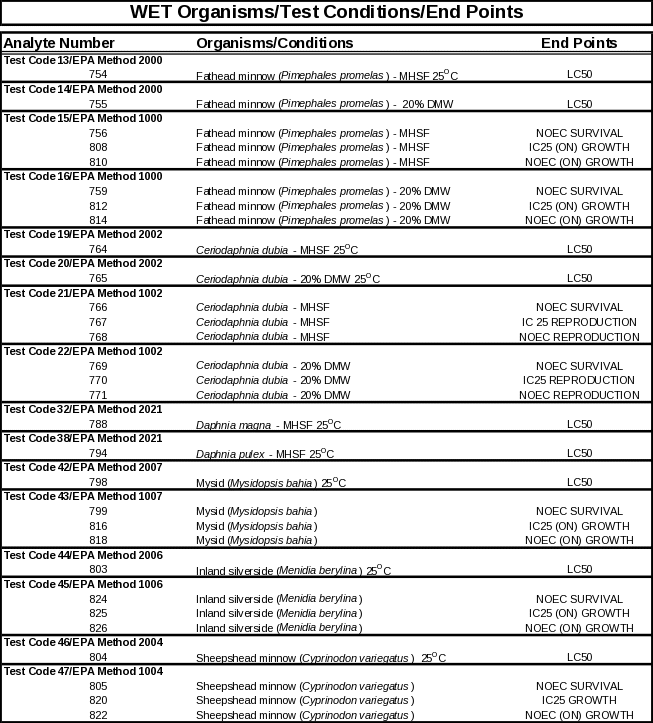
APPENDIX B: LIST OF TOP CHEMISTRY & MICROBIOLOGY ANALYTES AND WET TEST METHODS AND TIMES FOR ANALYZING
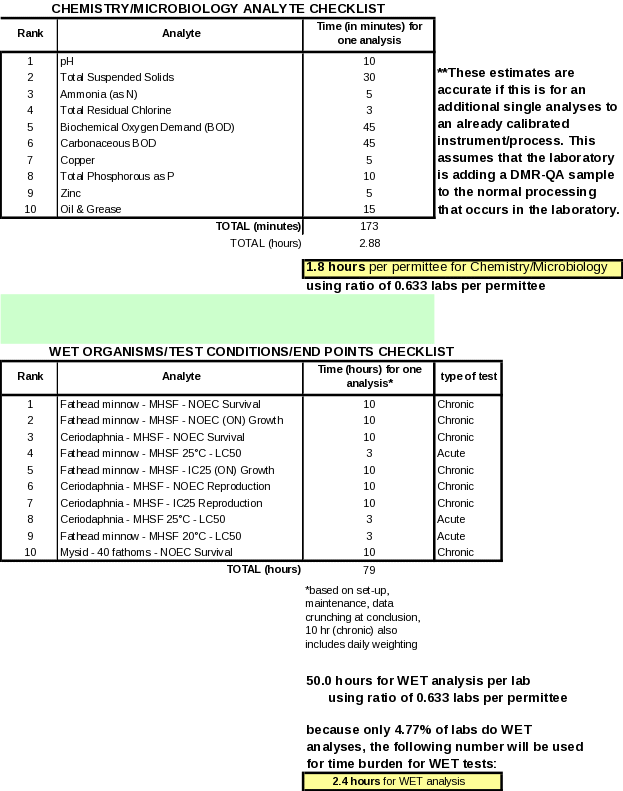
| File Type | application/msword |
| File Title | Information Collection Request for |
| File Modified | 2010-10-08 |
| File Created | 2010-10-01 |
© 2025 OMB.report | Privacy Policy